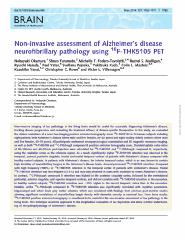Please use this identifier to cite or link to this item:
https://ahro.austin.org.au/austinjspui/handle/1/12151| Title: | Non-invasive assessment of Alzheimer's disease neurofibrillary pathology using 18F-THK5105 PET. | Austin Authors: | Okamura, Nobuyuki;Furumoto, Shozo;Fodero-Tavoletti, Michelle T;Mulligan, Rachel S ;Harada, Ryuichi;Yates, Paul;Pejoska, Svetlana;Kudo, Yukitsuka;Masters, Colin L ;Yanai, Kazuhiko;Rowe, Christopher C ;Villemagne, Victor L | Affiliation: | 4 Centre for PET, Austin Health, Melbourne, Australia 3 The Florey Institute of Neuroscience and Mental Health, The University of Melbourne, Australia6 The Mental Health Research Institute, Melbourne, Australia 3 The Florey Institute of Neuroscience and Mental Health, The University of Melbourne, Australia4 Centre for PET, Austin Health, Melbourne, Australia Department of Pharmacology, Tohoku University School of Medicine, Sendai, Japan nookamura@med.tohoku.ac.jp. 2 Cyclotron and Radioisotope Centre, Tohoku University, Sendai, Japan. Department of Pharmacology, Tohoku University School of Medicine, Sendai, Japan. 5 Clinical Research, Innovation and Education Centre, Tohoku University Hospital, Sendai, Japan. Department of Pharmacology, Tohoku University School of Medicine, Sendai, Japan2 Cyclotron and Radioisotope Centre, Tohoku University, Sendai, Japan. |
Issue Date: | 27-Mar-2014 | Publication information: | Brain : A Journal of Neurology 2014; 137(Pt 6): 1762-71 | Abstract: | Non-invasive imaging of tau pathology in the living brain would be useful for accurately diagnosing Alzheimer's disease, tracking disease progression, and evaluating the treatment efficacy of disease-specific therapeutics. In this study, we evaluated the clinical usefulness of a novel tau-imaging positron emission tomography tracer 18F-THK5105 in 16 human subjects including eight patients with Alzheimer's disease (three male and five females, 66-82 years) and eight healthy elderly controls (three male and five females, 63-76 years). All participants underwent neuropsychological examination and 3D magnetic resonance imaging, as well as both 18F-THK5105 and 11C-Pittsburgh compound B positron emission tomography scans. Standard uptake value ratios at 90-100 min and 40-70 min post-injection were calculated for 18F-THK5105 and 11C-Pittsburgh compound B, respectively, using the cerebellar cortex as the reference region. As a result, significantly higher 18F-THK5105 retention was observed in the temporal, parietal, posterior cingulate, frontal and mesial temporal cortices of patients with Alzheimer's disease compared with healthy control subjects. In patients with Alzheimer's disease, the inferior temporal cortex, which is an area known to contain high densities of neurofibrillary tangles in the Alzheimer's disease brain, showed prominent 18F-THK5105 retention. Compared with high frequency (100%) of 18F-THK5105 retention in the temporal cortex of patients with Alzheimer's disease, frontal 18F-THK5105 retention was less frequent (37.5%) and was only observed in cases with moderate-to-severe Alzheimer's disease. In contrast, 11C-Pittsburgh compound B retention was highest in the posterior cingulate cortex, followed by the ventrolateral prefrontal, anterior cingulate, and superior temporal cortices, and did not correlate with 18F-THK5105 retention in the neocortex. In healthy control subjects, 18F-THK5105 retention was ∼10% higher in the mesial temporal cortex than in the neocortex. Notably, unlike 11C-Pittsburgh compound B, 18F-THK5105 retention was significantly correlated with cognitive parameters, hippocampal and whole brain grey matter volumes, which was consistent with findings from previous post-mortem studies showing significant correlations of neurofibrillary tangle density with dementia severity or neuronal loss. From these results, 18F-THK5105 positron emission tomography is considered to be useful for the non-invasive assessment of tau pathology in the living brain. This technique would be applicable to the longitudinal evaluation of tau deposition and allow a better understanding of the pathophysiology of Alzheimer's disease. | URI: | https://ahro.austin.org.au/austinjspui/handle/1/12151 | DOI: | 10.1093/brain/awu064 | Journal: | Brain | URL: | https://pubmed.ncbi.nlm.nih.gov/24681664 | Type: | Journal Article | Subjects: | Alzheimer’s disease Alzheimer’s disease pathology PET amyloid positron emission tomography Aged Aged, 80 and over Alzheimer Disease.pathology.radionuclide imaging Amyloid beta-Peptides.metabolism Aniline Compounds.diagnostic use Brain Mapping.methods Carbon Radioisotopes.diagnostic use Female Humans Male Neurofibrillary Tangles.pathology.radionuclide imaging Plaque, Amyloid.pathology Positron-Emission Tomography.methods Quinolines.diagnostic use Radiopharmaceuticals.diagnostic use Thiazoles.diagnostic use |
| Appears in Collections: | Journal articles |
Files in This Item:
| File | Description | Size | Format | |
|---|---|---|---|---|
| 24681664.pdf | 534.43 kB | Adobe PDF |  View/Open |
Page view(s)
106
checked on Apr 30, 2025
Download(s)
130
checked on Apr 30, 2025
Google ScholarTM
Check
Items in AHRO are protected by copyright, with all rights reserved, unless otherwise indicated.
